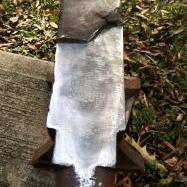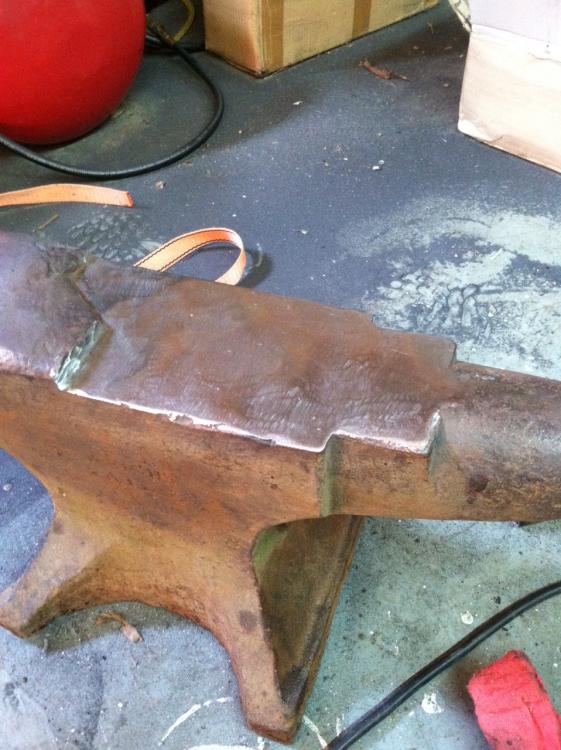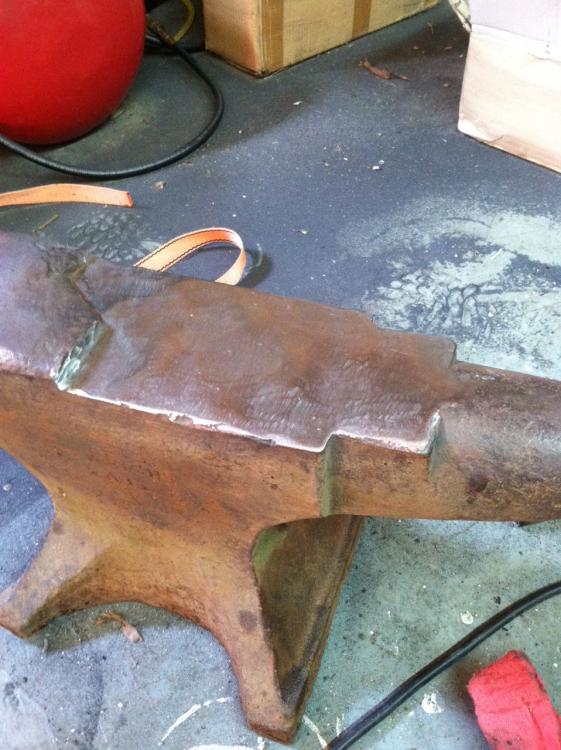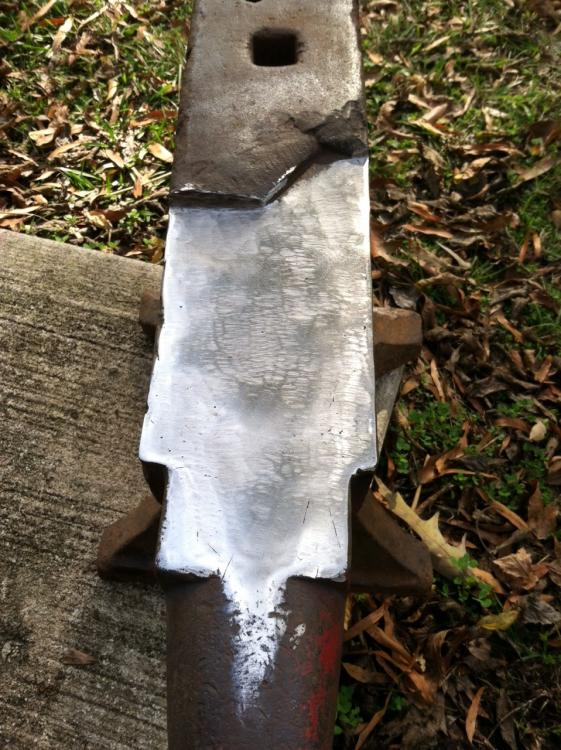-
Posts
76 -
Joined
-
Last visited
Content Type
Profiles
Forums
Articles
Gallery
Downloads
Events
Everything posted by Worshipdrummer
-
How did you get your sheep's horn straight and flat for a scale? Boiling? I have a large supply of Ram's Horn but I am not sure how to process it correctly.
-
Has anyone tried any kind of anti-rust coating (OTHER THAN OIL) on your non stainless knives? If so what and how is it applied?
-

I was given a Peter Wright Anvil but...
Worshipdrummer replied to Worshipdrummer's topic in Anvil Reviews by brand
Upon a retest, the middle third is more like %45. -

I was given a Peter Wright Anvil but...
Worshipdrummer replied to Worshipdrummer's topic in Anvil Reviews by brand
If you divide the repaired section into thirds starting close to the hardy area, It rebounds my lightest ball peen hammer (I do not have a bearing) about 65% for first third, middle third about 55% then the last third including the step to the horn about 70%. In other words the center of the repaired area has noticeably less rebound than the rest but it is by no means dead. -

I was given a Peter Wright Anvil but...
Worshipdrummer replied to Worshipdrummer's topic in Anvil Reviews by brand
This is a picture when he was almost finished. There is a little less of a step between hardy area and the rest but this is accurate. -
In honesty, aesthetically , the knife is ready to be treated and finished. My advice was for the "grunt" work of getting rid of the hammer marks and stuff. I like what you have done a lot. Was it a stock removal or did you forge it?
-

I was given a Peter Wright Anvil but...
Worshipdrummer replied to Worshipdrummer's topic in Anvil Reviews by brand
I m happy for this debate to continue if you guys wish for educational purposes but for better or worse, my friend melted some residual steel that was left of the top into the base and quenched it to harden. I may not get maximum energy transference to the project piece but the anvil is solid, flat and I can use it. I really appreciate all of the advice because it gave me options. I will let you guys know how it performs long term. -

I was given a Peter Wright Anvil but...
Worshipdrummer replied to Worshipdrummer's topic in Anvil Reviews by brand
I got it, sounds good. Thanks for taking the time to send it. -
You may just want to look into a set of the testing files because like you said the steel composition from spring to spring will differ so one hardness test on one spring will not work to give consistent accurate information. There is a tool company named for a very large species of bear which has a set of the files for $40 on their site. There is also some very good info on this site about a general heat treat technique for spring steel. Sounds like you are up front with all involved in selling or purchasing your knives so I do not think there is more you can do. Also, just because someone buys tool/knife steel it does not mean they are not forging the blades themselves I know many who purchase drill rod and forge it into blades. I actually prefer to start with the round or rod shape when I forge a blade don't know why I just do.
-
I love making knives out of coil/leaf springs that are bound for the scrap yard so I can sympathize with your choice to redeem them into a useful tool. However, I do not sell any of the knives I make from reclaimed springs for the same reasons as listed in multiple areas on this forum. I give the knives away to friends (telling them they may be great steel or not) or use them myself. Making a knife (correctly) requires a lot of work so if I was going to charge a price worthy of such work I would use known steel so the buyer (and you) can be assured of the steel quality and consistency. Again, there is nothing wrong with making a knife out of redeemed spring steel but I would not sell them, particularly at custom knife prices. Just my opinion; there are many here more learned than I.
-
Can you post a couple of pictures? You have to be careful with the shape of the knife handle when using kydex because it will take on the shape of the handle and if there is no flex in the sheath it will bind the knife when you try to draw or replace it. Your top tension rivet may be too high on the sheath as well. A picture will help. I also do not tape my blades when forming kydex as that will alter the profile. As far as the foam sticking; some kinds of foam will melt to the kydex. I first used regular closed cell foam like you would find on a yoga mat from a store. It melted to the kydex so I ordered some different foam from a knife maker site and it does not stick.
-

I was given a Peter Wright Anvil but...
Worshipdrummer replied to Worshipdrummer's topic in Anvil Reviews by brand
Maybe we have a different definition of the word "solder". Here it means melting soft lead wire to make electrical connections. I have a piece of hardened tool steel I could use, describe what you mean please Gote. -

Wrapped eye leafspring hawks
Worshipdrummer replied to Frozenthunderbolt's topic in Axes, Hatchets, Hawks, Choppers, etc
I have thought of trying something like this because I lack a hawk drift right now. I wondered about the wrapped handle eye but I had a thought to punch a small hole in the wrapped section and install a nail into the handle to "set" it firmly on the handle. You have inspired me I think I will give it a try this weekend. -
Great first knife. There is a real nice tutorial located here that will help you build a simple jig to grind your edges. I hope we can post links like this if not please delete it and forgive me. http://goughcustom.com/blog/2013-08-16-making-a-filing-jig/making-and-using-a-bevel-filing-jig.html
-
Maybe some 40 grit paper, a flat surface and a random orbital sander for the gross work? I would switch to hand tools as soon as I got any where close to my goal.
-

I was given a Peter Wright Anvil but...
Worshipdrummer replied to Worshipdrummer's topic in Anvil Reviews by brand
I really appreciate all of the advice on fixing the anvil. My friend worked on it and it has a pretty decent hard flat section now that I can do some light work on so I am going to leave it as is and put my money into a "new" old anvil in the spring. I hammered down on it this weekend drawing out a piece of school bus leaf spring and it held up well, no dents or new damage. It does seem to ring more now than it previously did but I know how to dampen that well enough. Again, thanks. -

I was given a Peter Wright Anvil but...
Worshipdrummer replied to Worshipdrummer's topic in Anvil Reviews by brand
Thanks for the "good news". I guess I will use my rail road track anvil and keep this one for the horn until tax time. -
Try drawing out school bus leaf springs. I have a ton of them but dang they are tough. I just like redeeming steel headed for the junk yard to rust into useful tools.
-

I was given a Peter Wright Anvil but...
Worshipdrummer replied to Worshipdrummer's topic in Anvil Reviews by brand
I was a little late he has already started working on the Anvil. Here are some pictures of what he has done so far. Should I let him weld new steel to even the entire surface or use it in its current condition. I am leaning toward the latter. -

I was given a Peter Wright Anvil but...
Worshipdrummer replied to Worshipdrummer's topic in Anvil Reviews by brand
I will get some pictures uploaded. Thanks for the info on Robb Gunter though I will send it to him. -
A good friend of mine "gave" me a Peter Wright Anvil (It is 150-170# at least) to work on but there is a problem. The striking face is broken. Part of the top, forward of the Hardy and Pritchel has broken away leaving a very uneven surface. Sort of looks like the state Florida actually. I have a friend who is a very good welder and he has offered to work on the anvil and try to restore it to a better working condition. I understand the value both monetary and historical but I would rather have the anvil flat and more useable than original. What do you guys think? Let him fix it and use the crap out of it or let it stay original and use the horn when needed?
-
Here are my first attempts at a knife. Both were made from a coil spring I sourced from an old racecar (I have a friend who builds them). They turned out a little rougher than I wanted but I learned a ton while completing them. I heated the coil up and hit it with a hammer until it told me what kind of knife it wanted to be. The more I hit them the more they looked like a kitchen knife so I went that direction. I am really not sure why my pics are upside down but the top one is the second knife the bottom the first. Top has rubber scales and the bottom has walnut scales.
-

I first started when...
Worshipdrummer replied to JamesH's topic in Blacksmithing, General Discussion
I have always had a drive to create. It started with simple woodworking projects and progressed into furniture, then bow making (think archery not presents) then customizing knives and now into blacksmithing. One thing I have noticed is that blacksmithing projects often involve aspects of all the other hobbies I mentioned as well; so I guess those were not a waste of time... -
I would finish the spike knife. The object may not function well as a knife but you will learn from trying to make it do so. I would go back and make some J-hooks and S-hooks using the horn of the anvil to form the hooks trying to leave as few hammer marks as you can. Just that simple task helped me understand that every part of an anvil has a specific purpose and some have many. Give the S hooks away to the females in you neighborhood they love them for hanging flower pots and stuff and it will ease their aversion to the sounds of steel being hammered in the neighborhood.
-
Third time is the charm: Just wanted to reach out and see if there are any other smiths in the Augusta area. I am new to the blacksmith craft. I started by watching a few live demos at different events then I read “The Blacksmith’s Craft”, I lurked here and elsewhere learning what I could while concealing my ignorance. I borrowed a broken anvil, acquired a section of rail, found a 3 pound cross peen hammer and built a rivet forge with stuff I had lying around. I started with a 14 inch piece of half inch square mild steel stock and turned it into a quarter inch piece of square stock then into a small piece of round stock. I am hooked. I have made and given away several S-hooks of various sizes and styles and a few J hooks with nails attached (I call them drive hooks). I recently sold a bow and a crossbow and purchased a Diamond Back gas forge. I sourced some free coil springs and leaf springs (from a bus) and I am practicing making tools, blades, tomahawks and anything else that interests me. I will move into working better and known steel after I am happy with the items I forge out of the free stuff. I have no real blacksmithing knowledge to add here (yet) but I am a fairly decent woodworker and bowyer if I can help anyone else. I welcome conversation and contact with anyone (especially locals) so feel free to holler if you wish…Chris



